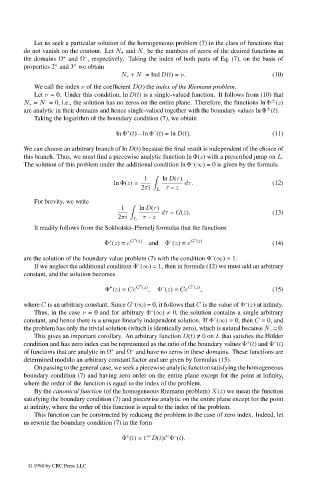Page 626 - Handbook Of Integral Equations
P. 626
Let us seek a particular solution of the homogeneous problem (7) in the class of functions that
do not vanish on the contour. Let N + and N – be the numbers of zeros of the desired functions in
–
+
the domains Ω and Ω , respectively. Taking the index of both parts of Eq. (7), on the basis of
properties 2 and 3 we obtain
◦
◦
N + + N – = Ind D(t)= ν. (10)
We call the index ν of the coefficient D(t) the index of the Riemann problem.
Let ν = 0. Under this condition, ln D(t) is a single-valued function. It follows from (10) that
N + = N – = 0, i.e., the solution has no zeros on the entire plane. Therefore, the functions ln Φ (z)
±
are analytic in their domains and hence single-valued together with the boundary values ln Φ (t).
±
Taking the logarithm of the boundary condition (7), we obtain
+
–
ln Φ (t) – ln Φ (t)=ln D(t). (11)
We can choose an arbitrary branch of ln D(t) because the final result is independent of the choice of
this branch. Thus, we must find a piecewise analytic function ln Φ(z) with a prescribed jump on L.
–
The solution of this problem under the additional condition ln Φ (∞) = 0 is given by the formula
1 ln D(τ)
ln Φ(z)= dτ. (12)
2πi τ – z
L
For brevity, we write
1 ln D(τ)
dτ = G(z). (13)
2πi L τ – z
It readily follows from the Sokhotski–Plemelj formulas that the functions
+
–
–
+
Φ (z)= e G (z) and Φ (z)= e G (z) (14)
–
are the solution of the boundary value problem (7) with the condition Φ (∞)=1.
–
If we neglect the additional condition Φ (∞) = 1, then in formula (12) we must add an arbitrary
constant, and the solution becomes
–
+
+
–
Φ (z)= Ce G (z) , Φ (z)= Ce G (z) , (15)
–
–
where C is an arbitrary constant. Since G (∞) = 0, it follows that C is the value of Φ (z)atinfinity.
–
Thus, in the case ν = 0 and for arbitrary Φ (∞) ≠ 0, the solution contains a single arbitrary
–
constant, and hence there is a unique linearly independent solution. If Φ (∞) = 0, then C = 0, and
the problem has only the trivial solution (which is identically zero), which is natural because N – =0.
This gives an important corollary. An arbitrary function D(t) ≠ 0on L that satisfies the H¨ older
+
–
condition and has zero index can be represented as the ratio of the boundary values Φ (t) and Φ (t)
+
–
of functions that are analytic in Ω and Ω and have no zeros in these domains. These functions are
determined modulo an arbitrary constant factor and are given by formulas (15).
On passing to the general case, we seek a piecewise analytic function satisfying the homogeneous
boundary condition (7) and having zero order on the entire plane except for the point at infinity,
where the order of the function is equal to the index of the problem.
By the canonical function (of the homogeneous Riemann problem) X(z) we mean the function
satisfying the boundary condition (7) and piecewise analytic on the entire plane except for the point
at infinity, where the order of this function is equal to the index of the problem.
This function can be constructed by reducing the problem to the case of zero index. Indeed, let
us rewrite the boundary condition (7) in the form
+
ν
–ν
–
Φ (t)= t D(t)t Φ (t).
© 1998 by CRC Press LLC
© 1998 by CRC Press LLC
Page 609

